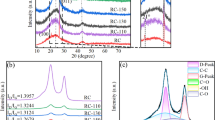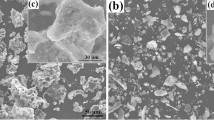Abstract
In this paper, floc sludge was transformed into porous carbon matrix composites by acidification and KOH activation at high temperature and used as an electrode material for application in capacitors. The effects of different treatment processes on the electrochemical properties of sludge materials were compared. The results of electrochemical tests showed that the sludge electrode exhibited excellent energy storage performance after HNO3 acidification and KOH activation with a mass ratio of 3:1 (KOH/C). The specific capacitance of the sludge electrode reached 287 F/g at a current density of 1 A/g. In addition, the sludge electrode material showed excellent cycle stability (specific capacity retained at 93.4% after 5000 cycles at 5 A/g). Based on XRD, FTIR, SEM, TEM, and BET surface analysis, the morphology of sludge electrode materials can be effectively regulated by chemical pretreatment. The best-performing material showed a 3D porous morphology with a large specific surface area (2588 m2/g) and optimal pore size distribution, improving ion channels and charge conductivity. According to the life cycle assessment of floc sludge utilization, it reduced the resource consumption and toxicity risk by more than 90% compared with ordinary sludge disposal processes. This work provided a cost-effective and eco-friendly sludge reuse method and demonstrated the application potential of sludge-based materials in high-performance supercapacitors.

Similar content being viewed by others
References
Ai F, Liu N, Wang W, Wang A, Wang F, Zhang H, Huang Y (2017). Heteroatoms-doped porous carbon derived from tuna bone for high performance Li-S batteries. Electrochimica Acta, 258: 80–89
Cao Z, Zheng X, Cao H, Zhao H, Sun Z, Guo Z, Wang K, Zhou B (2018). Efficient reuse of anode scrap from lithium-ion batteries as cathode for pollutant degradation in electro-Fenton process: Role of different recovery processes. Chemical Engineering Journal, 337: 256–264
Eid E M, Alrumman S A, Galal T M, El-Bebany A F (2019). Regression models for monitoring trace metal accumulations by Faba sativa Bernh. plants grown in soils amended with different rates of sewage sludge. Scientific Reports, 9(1): 5443
Fan L, Liu P F, Yan X, Gu L, Yang Z Z, Yang H G, Qiu S, Yao X (2016). Atomically isolated nickel species anchored on graphitized carbon for efficient hydrogen evolution electrocatalysis. Nature Communications, 7(1): 10667
Feki E, Battimelli A, Sayadi S, Dhouib A, Khoufi S (2020). High-rate anaerobic digestion of waste activated sludge by integration of electro-Fenton process. Molecules (Basel, Switzerland), 25(3): 626
Feng H, Zheng M, Dong H, Xiao Y, Hu H, Sun Z, Long C, Cai Y, Zhao X, Zhang H, Lei B, Liu Y (2015). Three-dimensional honeycomblike hierarchically structured carbon for high-performance supercapacitors derived from high-ash-content sewage sludge. Journal of Materials Chemistry. A, Materials for Energy and Sustainability, 3(29): 15225–15234
Giebułtowicz J, Nałęcz-Jawecki G, Harnisz M, Kucharski D, Korzeniewska E, Płaza G (2020). Environmental risk and risk of resistance selection due to antimicrobials’ occurrence in two polish wastewater treatment plants and receiving surface water. Molecules (Basel, Switzerland), 25(6): 1470
Guo M, Song W, Tian J (2020). Biochar-facilitated soil remediation: mechanisms and efficacy variations. Frontiers in Environmental Science, 8: 521512
IKE (2020). eBalance v.4.7.14122.518. Chengdu: IT Knowledge & Education
Jin Z, Ji F, He Y, Zhao M, Xu X, Zheng X Y (2017). Evaluating the efficiency of carbon utilisation via bioenergetics between biological aerobic and denitrifying phosphorus removal systems. PLoS One, 12(10): e0187007
Laipan M, Fu H, Zhu R, Sun L, Zhu J, He H (2017). Converting spent Cu/Fe layered double hydroxide into Cr(VI) reductant and porous carbon material. Scientific Reports, 7(1): 7277
Lei Z, Liu L, Zhao H, Liang F, Chang S, Li L, Zhang Y, Lin Z, Kröger J, Lei Y (2020). Nanoelectrode design from microminiaturized honeycomb monolith with ultrathin and stiff nanoscaffold for high-energy micro-supercapacitors. Nature Communications, 11(1): 299
Li M, Liu C, Cao H, Zhao H, Zhang Y, Fan Z (2014). KOH self-templating synthesis of three-dimensional hierarchical porous carbon materials for high performance supercapacitors. Journal of Materials Chemistry. A, Materials for Energy and Sustainability, 2(36): 14844–14851
Li T, Ma R, Lin J, Hu Y, Zhang P, Sun S, Fang L (2020). The synthesis and performance analysis of various biomass-based carbon materials for electric double-layer capacitors: A review. International Journal of Energy Research, 44(4): 2426–2454
Li X, Chen L, Mei Q, Dong B, Dai X, Ding G, Zeng E Y (2018). Microplastics in sewage sludge from the wastewater treatment plants in China. Water Research, 142: 75–85
Li X, Hao T, Tang Y, Chen G (2021). A “Seawater-in-Sludge” approach for capacitive biochar production via the alkaline and alkaline earth metals activation. Frontiers of Environmental Science & Engineering, 15(1): 3
Li X, Liu K, Liu Z, Wang Z, Li B, Zhang D (2017). Hierarchical porous carbon from hazardous waste oily sludge for all-solid-state flexible supercapacitor. Electrochimica Acta, 240: 43–52
Li Z, Zhang L, Amirkhiz B S, Tan X, Xu Z, Wang H, Olsen B C, Holt C M B, Mitlin D (2012). Carbonized chicken eggshell membranes with 3D architectures as high-performance electrode materials for supercapacitors. Advanced Energy Materials, 2(4): 431–437
Liang Q, Liu Y, Chen M, Ma L, Yang B, Li L, Liu Q (2020). Optimized preparation of activated carbon from coconut shell and municipal sludge. Materials Chemistry and Physics, 241: 122327
Lin X, Chen X, Li S, Chen Y, Wei Z, Wu Q (2021). Sewage sludge ditch for recovering heavy metals can improve crop yield and soil environmental quality. Frontiers of Environmental Science & Engineering, 15(2): 22
Liu W, Iordan C M, Cherubini F, Hu X, Fu D (2020). Environmental impacts assessment of wastewater treatment and sludge disposal systems under two sewage discharge standards: A case study in Kunshan, China. Journal of Cleaner Production, 287: 125046
Liu X, Liu L, Leng P, Hu Z (2019). Feasible and effective reuse of municipal sludge for vegetation restoration: physiochemical characteristics and microbial diversity. Scientific Reports, 9(1): 879
Mandal B K, Vankayala R, Uday Kumar L (2011). Speciation of chromium in soil and sludge in the surrounding tannery region, ranipet, Tamil Nadu. ISRN Toxicology, 2011: 697980
Mirbagheri M, Nahvi I, Emamzade R (2015). Reduction of chemical and biological oxygen demands from oil wastes via oleaginous fungi: an attempt to convert food by products to essential fatty acids. Iranian Journal of Biotechnology, 13(2): 25–30
Mitravinda T, Nanaji K, Anandan S, Jyothirmayi A, Chakravadhanula V S K, Sharma C S, Rao T N (2018). Facile synthesis of corn silk derived nanoporous carbon for an improved supercapacitor performance. Journal of the Electrochemical Society, 165(14): A3369–A3379
Muniandy L, Adam F, Mohamed A R, Ng E P (2014). The synthesis and characterization of high purity mixed microporous/mesoporous activated carbon from rice husk using chemical activation with NaOH and KOH. Microporous and Mesoporous Materials, 197: 316–323
Rashidi N A, Yusup S (2020). Recent methodological trends in nitrogen-functionalized activated carbon production towards the gravimetric capacitance: A mini review. Journal of Energy Storage, 32: 101757
Sadri Moghaddam S, Alavi Moghaddam M R, Arami M (2010). Coagulation/flocculation process for dye removal using sludge from water treatment plant: optimization through response surface methodology. Journal of Hazardous Materials, 175(1–3): 651–657
Smith K M, Fowler G D, Pullket S, Graham N J (2009). Sewage sludge-based adsorbents: a review of their production, properties and use in water treatment applications. Water Research, 43(10): 2569–2594
Tobiszewski M, Marć M, Gałuszka A, Namieśnik J (2015). Green chemistry metrics with special reference to green analytical chemistry. Molecules (Basel, Switzerland), 20(6): 10928–10946
Wang D W, Li F, Liu M, Lu G Q, Cheng H M (2008). 3D aperiodic hierarchical porous graphitic carbon material for high-rate electrochemical capacitive energy storage. Angewandte Chemie (International ed. in English), 120(2): 379–382
Wang H, Li Z, Tak J K, Holt C M B, Tan X, Xu Z, Amirkhiz B S, Harfield D, Anyia A, Stephenson T, Mitlin D (2013a). Supercapacitors based on carbons with tuned porosity derived from paper pulp mill sludge biowaste. Carbon, 57: 317–328
Wang L, Wang R, Zhao H, Liu L, Jia D (2015a). High rate performance porous carbon prepared from coal for supercapacitors. Materials Letters, 149: 85–88
Wang L, Yang C, Thangavel S, Guo Z, Chen C, Wang A, Liu W (2021). Enhanced hydrogen production in microbial electrolysis through strategies of carbon recovery from alkaline/thermal treated sludge. Frontiers of Environmental Science & Engineering, 15(4): 56
Wang T, Peng Z, Wang Y, Tang J, Zheng G (2013b). MnO nanoparticle@mesoporous carbon composites grown on conducting substrates featuring high-performance lithium-ion battery, supercapacitor and sensor. Scientific Reports, 3(1): 2693
Wang Y K, Pan X R, Geng Y K, Sheng G P (2015b). Simultaneous effective carbon and nitrogen removals and phosphorus recovery in an intermittently aerated membrane bioreactor integrated system. Scientific Reports, 5(1): 16281
Xia W, Qiu B, Xia D, Zou R (2013). Facile preparation of hierarchically porous carbons from metal-organic gels and their application in energy storage. Scientific Reports, 3(1): 1935
Xiang R, Liu J C, Xu Y, Liu Y Q, Nai C X, Dong L, Huang Q F (2020). Framework, method and case study for the calculation of end of life for HWL and parameter sensitivity analysis. Scientific Reports, 10(1): 19509
Xu Z X, Deng X Q, Zhang S, Shen Y F, Shan Y Q, Zhang Z M, Luque R, Duan P G, Hu X (2020). Benign-by-design N-doped carbonaceous materials obtained from the hydrothermal carbonization of sewage sludge for supercapacitor applications. Green Chemistry, 22(12): 3885–3895
Yakaboylu G A, Jiang C, Yumak T, Zondlo J W, Wang J, Sabolsky E M (2021). Engineered hierarchical porous carbons for supercapacitor applications through chemical pretreatment and activation of biomass precursors. Renewable Energy, 163: 276–287
Yue X M, An Z Y, Ye M, Liu Z J, Xiao C C, Huang Y, Han Y J, Zhang S Q, Zhu J S (2019). Preparation of porous activated carbons for high performance supercapacitors from Taixi anthracite by multi-stage activation. Molecules (Basel, Switzerland), 24(19): 3588
Yui K, Kuramochi H, Osako M (2018). Understanding the behavior of radioactive cesium during the incineration of contaminated municipal solid waste and sewage sludge by thermodynamic equilibrium calculation. ACS Omega, 3(11): 15086–15099
Zhang J, Deng R J, Ren B Z, Hou B, Hursthouse A (2019). Preparation of a novel Fe3O4/HCO composite adsorbent and the mechanism for the removal of antimony (III) from aqueous solution. Scientific Reports, 9(1): 13021
Acknowledgements
We gratefully acknowledge the funding by National Natural Science Foundation of China (Grant No. 51978643) and Youth Innovation Promotion Association, CAS (2014037).
Author information
Authors and Affiliations
Corresponding author
Additional information
Highlights
• The feasibility of facile fabrication of capacitor from floc sludge is discussed.
• The porous carbon composites are obtained by acidification and KOH activation.
• The as-prepared 3D structure has large surface area and optimal pore size.
• Admirable specific capacitance and outstanding cycling stability are obtained.
Supplementary Materials
Rights and permissions
About this article
Cite this article
Zhang, D., Hou, R., Wang, W. et al. Recovery and reuse of floc sludge for high-performance capacitors. Front. Environ. Sci. Eng. 16, 78 (2022). https://doi.org/10.1007/s11783-021-1512-5
Received:
Revised:
Accepted:
Published:
DOI: https://doi.org/10.1007/s11783-021-1512-5




